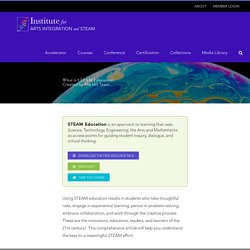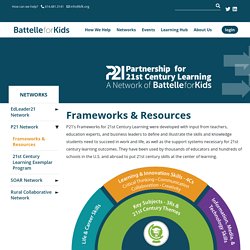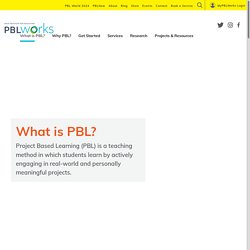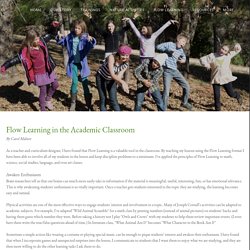

Seven Essentials for Project-Based Learning. Maker Education. 5 Keys to Rigorous Project-Based Learning. Five Keys Video Series See Edutopia's core strategies in action with our Five Keys video series. Take a deeper look at each strategy as we share the nuts and bolts of program implementation, give voice to examples from schools around the country, and illuminate the research behind the practices. VIDEO: Establishing Real-World Connections in Projects (Keys to PBL Series Part 1) Students are more engaged when learning relates directly to the world they live in.
See how to extend your projects beyond classroom walls. VIDEO: Building Rigorous Projects That Are Core to Learning (Keys to PBL Series Part 2) Project-based learning doesn't mean leaving standards behind. VIDEO: Structuring Collaboration for Student Success (Keys to PBL Series Part 3) PBL provides a unique opportunity to help students practice critical thinking, collaboration, communication, and creativity. The Institute for Arts Integration and STEAM. As more schools are shifting to include a STEAM approach, there’s a general question that many start to ask: Who are the STEAM teachers?

Then, of course, we start to explore follow up questions like: When does STEAM occur? Is it a class or is it throughout the day? What makes a person qualified to teach STEAM? Are there STEAM credentials? Once you head down this path, you start to see all of the forks in the road. Who teaches STEAM? The answer to this is one is easy: everyone. This can seem oversimplified, but honestly, it’s an inherent quality of this approach. By limiting or labeling someone as the “STEAM Teacher”, you’re cutting out the very heart of this idea.
This goes back to the idea of “it’s not my job to teach that”. “It’s not my job to teach those kindergarteners to tie their shoes.” “It’s not my job to explain basic math functions to these kids.” Battelle for Kids. P21’s Frameworks for 21st Century Learning were developed with input from teachers, education experts, and business leaders to define and illustrate the skills and knowledge students need to succeed in work and life, as well as the support systems necessary for 21st century learning outcomes.

They have been used by thousands of educators and hundreds of schools in the U.S. and abroad to put 21st century skills at the center of learning. Battelle for Kids looks forward to engaging yet again with educators and other experts to update the Frameworks. We encourage personal use of these Frameworks by all who can benefit: What is Project Based Learning? How does PBL differ from “doing a project”?

PBL is becoming widely used in schools and other educational settings, with different varieties being practiced. However, there are key characteristics that differentiate "doing a project" from engaging in rigorous Project Based Learning. We find it helpful to distinguish a "dessert project" - a short, intellectually-light project served up after the teacher covers the content of a unit in the usual way - from a "main course" project, in which the project is the unit.
In Project Based Learning, the project is the vehicle for teaching the important knowledge and skills student need to learn. The project contains and frames curriculum and instruction. In contrast to dessert projects, PBL requires critical thinking, problem solving, collaboration, and various forms of communication. Learn more about "dessert" projects vs PBL The gold standard for high-quality PBL The Gold Standard PBL model encompasses two useful guides for educators: The Benefits of Being Goofy. How to Help Students Ask Better Questions by Creating a Culture of Inquiry.
Treating Challenges as Design Opportunities. Schlechty's Levels of Engagement. Five Ways to Boost Student Engagement with Flow Theory. Flow Learning in Academic Classroom. Flow Learning in the Academic ClassroomBy Carol MalnorAs a teacher and curriculum designer, I have found that Flow Learning is a valuable tool in the classroom.

By teaching my lessons using the Flow Learning format I have been able to involve all of my students in the lesson and keep discipline problems to a minimum. I've applied the principles of Flow Learning to math, science, social studies, language, and even art classes.Awaken EnthusiasmBrain researchers tell us that our brains can much more easily take in information if the material is meaningful, useful, interesting, fun, or has emotional relevance.
This is why awakening students' enthusiasm is so vitally important. Once a teacher gets students interested in the topic they are studying, the learning becomes easy and natural.Physical activities are one of the most effective ways to engage students' interest and involvement in a topic. Many of Joseph Cornell's activities can be adapted to academic subjects. Mihaly Csikszentmihalyi: Flow, the secret to happiness. Response: "Flow" In The Classroom.